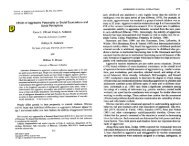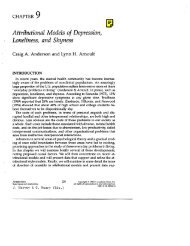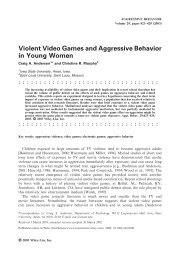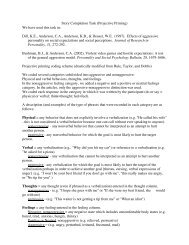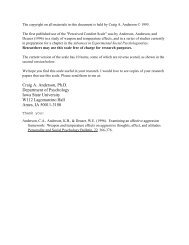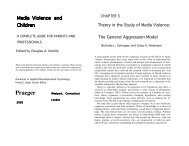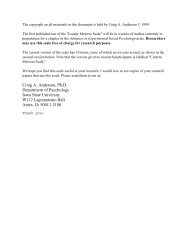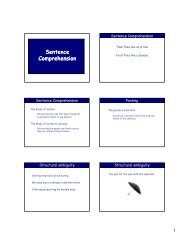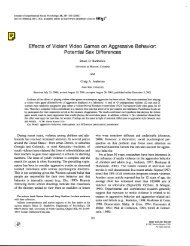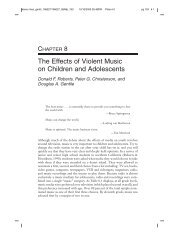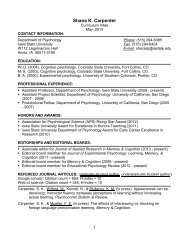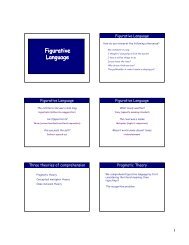Holland's RIASEC Model as an Integrative Framework for Individual ...
Holland's RIASEC Model as an Integrative Framework for Individual ...
Holland's RIASEC Model as an Integrative Framework for Individual ...
Create successful ePaper yourself
Turn your PDF publications into a flip-book with our unique Google optimized e-Paper software.
16 ARMSTRONG, DAY, MCVAY, AND ROUNDS<br />
function in environments will incre<strong>as</strong>e the potential effectiveness<br />
of these me<strong>as</strong>ures in applied settings, such <strong>as</strong> career counseling.<br />
Org<strong>an</strong>izing individual-differences in<strong>for</strong>mation around <strong>an</strong> interest<br />
structure provides <strong>an</strong> import<strong>an</strong>t contextual framework <strong>for</strong> underst<strong>an</strong>ding<br />
the interrelations between me<strong>as</strong>ures, <strong>an</strong>d this will also<br />
incre<strong>as</strong>e the potential effectiveness of these me<strong>as</strong>ures. The development<br />
of <strong>an</strong> integrated model of individual differences would<br />
provide a template <strong>for</strong> the more coherent <strong>an</strong>d systematic delivery<br />
of in<strong>for</strong>mation in career counseling <strong>an</strong>d other applied settings.<br />
References<br />
Ackerm<strong>an</strong>, P. L. (1999). Traits <strong>an</strong>d knowledge <strong>as</strong> determin<strong>an</strong>ts of learning<br />
<strong>an</strong>d individual differences: Putting it all together. In P. L. Ackerm<strong>an</strong>,<br />
P. C. Kyllonen, & R. D. Roberts (Eds.), Learning <strong>an</strong>d individual<br />
differences: Process, trait, <strong>an</strong>d content determin<strong>an</strong>ts (pp. 437–462).<br />
W<strong>as</strong>hington, DC: Americ<strong>an</strong> Psychological Association.<br />
Ackerm<strong>an</strong>, P. L., & Heggestad, E. D. (1997). Intelligence, personality, <strong>an</strong>d<br />
interests: Evidence <strong>for</strong> overlapping traits. Psychological Bulletin, 121,<br />
219–245.<br />
Ackerm<strong>an</strong>, P. L., K<strong>an</strong>fer, R., & Goff, M. (1995). Cognitive <strong>an</strong>d noncognitive<br />
determin<strong>an</strong>ts <strong>an</strong>d consequences of complex skill acquisition. Journal<br />
of Experimental Psychology: Applied, 1, 270–304.<br />
ACT, Inc. (1995). Technical m<strong>an</strong>ual: Revised unisex edition of the ACT<br />
Interest Inventory. Iowa City, IA: Americ<strong>an</strong> College Testing Program.<br />
Anderson, J. R. (1993). Problem solving <strong>an</strong>d learning. Americ<strong>an</strong> Psychologist,<br />
48, 35–44.<br />
Armstrong, P. I., Smith, T. J., Donnay, D. A. C., & Rounds, J. (2004). The<br />
Strong ring: A b<strong>as</strong>ic interests model of occupational structure. Journal of<br />
Counseling Psychology, 51, 299–313.<br />
Barrick, M. R., Mount, M. K., & Gupta, R. (2003). Meta-<strong>an</strong>alysis of the<br />
relationship between the five factor model of personality <strong>an</strong>d Holl<strong>an</strong>d’s<br />
occupational types. Personnel Psychology, 51, 45–74.<br />
Blishen, B. B., Carroll, W. K., & Moore, C. (1987). The 1981 socioeconomic<br />
index <strong>for</strong> occupations in C<strong>an</strong>ada. C<strong>an</strong>adi<strong>an</strong> Review of Sociology<br />
<strong>an</strong>d Anthropology, 24, 465–488.<br />
Bolton, B. (1985). Discrimin<strong>an</strong>t <strong>an</strong>alysis of Holl<strong>an</strong>d’s occupational types<br />
using the Sixteen Personality Factor Questionnaire. Journal of Vocational<br />
Behavior, 27, 210–217.<br />
Borgen, F. H. (1999). New horizons in interest theory <strong>an</strong>d me<strong>as</strong>urement:<br />
Toward exp<strong>an</strong>ded me<strong>an</strong>ing. In M. L. Savick<strong>as</strong> & A. R. Spok<strong>an</strong>e (Eds.),<br />
Vocational interests: Me<strong>an</strong>ing, me<strong>as</strong>urement, <strong>an</strong>d counseling use (pp.<br />
383–411). Palo Alto, CA: Davies-Black.<br />
Borgen, F. H., Weiss, D. J., Tinsley, H. E. A., Dawis, R. V., & Lofquist,<br />
L. H. (1968). The me<strong>as</strong>urement of occupational rein<strong>for</strong>cement patterns.<br />
In Minnesota Studies in Vocational Rehabilitation, XXV. Minneapolis:<br />
University of Minnesota.<br />
Campbell, D. P. (1971). H<strong>an</strong>dbook <strong>for</strong> the Strong Vocational Interest<br />
Bl<strong>an</strong>k. St<strong>an</strong><strong>for</strong>d, CA: St<strong>an</strong><strong>for</strong>d University Press.<br />
Campbell, D. P., & Borgen, F. H. (1999). Holl<strong>an</strong>d’s theory <strong>an</strong>d the<br />
development of interest inventories. Journal of Vocational Behavior, 55,<br />
86–101.<br />
Campbell, J. P., McCloy, R. A., Oppler, S. H., & Sager, C. E. (1993). A<br />
theory of per<strong>for</strong>m<strong>an</strong>ce. In R. Schmitt & W. C. Borm<strong>an</strong> (Eds.), Personnel<br />
selection in org<strong>an</strong>izations (pp. 35–70). S<strong>an</strong> Fr<strong>an</strong>cisco: Jossey-B<strong>as</strong>s.<br />
Cattell, R. B. (1973). Personality <strong>an</strong>d mood by questionnaire. S<strong>an</strong> Fr<strong>an</strong>cisco:<br />
Jossey-B<strong>as</strong>s.<br />
Cattell, R. B., Eber, H. W., & Tatsuoka, M. M. (1970). H<strong>an</strong>dbook <strong>for</strong> the<br />
16-PF. Champaign, IL: Institute <strong>for</strong> Personality <strong>an</strong>d Ability Testing.<br />
Clark, K. E. (1961). The vocational interests of nonprofessional men.<br />
Minneapolis: University of Minnesota Press.<br />
Costa, P. T., & McCrae, R. R. (1992). Revised NEO-Personality Inventory<br />
(NEO-PI-R) <strong>an</strong>d NEO Five Factor Inventory (NEO-FFI): Professional<br />
m<strong>an</strong>ual. Odessa, FL: Psychological Assessment Resources.<br />
Costa, P. T., McCrae, R. R., & Holl<strong>an</strong>d, J. L. (1984). Personality <strong>an</strong>d<br />
vocational interests in <strong>an</strong> adult sample. Journal of Applied Psychology,<br />
69, 390–400.<br />
Cr<strong>an</strong>e, N. (2002). Mercator: The m<strong>an</strong> who mapped the pl<strong>an</strong>et. London:<br />
Weidenfeld & Nicolson.<br />
Dawis, R. V. (1992). The individual differences tradition in counseling<br />
psychology. Journal of Counseling Psychology, 39, 7–19.<br />
Dawis, R. V., & Lofquist, L. (1984). A psychological theory of work<br />
adjustment: An individual differences model <strong>an</strong>d its applications. Minneapolis:<br />
University of Minnesota Press.<br />
De Fruyt, F., & Mervielde, I. (1997). The five-factor model of personality<br />
<strong>an</strong>d Holl<strong>an</strong>d’s <strong>RIASEC</strong> interest types. Personality <strong>an</strong>d <strong>Individual</strong> Differences,<br />
23, 87–103.<br />
Deng, C.-P., Armstrong, P. I., & Rounds, J. (2007). The fit of Holl<strong>an</strong>d’s<br />
<strong>RIASEC</strong> model to US occupations. Journal of Vocational Behavior, 71,<br />
1–22.<br />
Digm<strong>an</strong>, J. M. (1990). Personality structure: Emergence of the five-factor<br />
model. Annual Review of Psychology, 41, 417–440.<br />
Einarsdottir, S. (2001). Structural equivalence of vocational interests<br />
across culture <strong>an</strong>d gender: Differential item functioning in the Strong<br />
Interest Inventory. Unpublished doctoral dissertation, University of Illinois<br />
at Urb<strong>an</strong>a–Champaign.<br />
Einarsdottir, S., & Rounds, J. (2000). Application of three dimensions of<br />
vocational interests to the Strong Interest Inventory. Journal of Vocational<br />
Behavior, 56, 363–379.<br />
Fitzgerald, L. F., & Hubert, L. J. (1987). Multidimensional scaling: Some<br />
possibilities <strong>for</strong> counseling psychology. Journal of Counseling Psychology,<br />
34, 469–480.<br />
Fleishm<strong>an</strong>, E. A., Cost<strong>an</strong>za, D. P., & Marshall-Mies, J. (1999). Abilities. In<br />
N. G. Peterson, M. D. Mum<strong>for</strong>d, W. C. Borm<strong>an</strong>, P. R. Je<strong>an</strong>neret, & E. A.<br />
Fleishm<strong>an</strong> (Eds.), An occupational in<strong>for</strong>mation system <strong>for</strong> the 21st<br />
century: The development of the O*NET (pp. 175–195). W<strong>as</strong>hington,<br />
DC: Americ<strong>an</strong> Psychological Association.<br />
Fleishm<strong>an</strong>, E. A., & Quaint<strong>an</strong>ce, M. K. (1984). Taxonomies of hum<strong>an</strong><br />
per<strong>for</strong>m<strong>an</strong>ce: The description of hum<strong>an</strong> t<strong>as</strong>ks. Orl<strong>an</strong>do, FL: Academic<br />
Press.<br />
French, J. R. P., Jr., Capl<strong>an</strong>, R. D., & Harrison, R. V. (1982). The<br />
mech<strong>an</strong>ism of job stress <strong>an</strong>d strain. New York: Wiley.<br />
Fryer, D. (1931). The me<strong>as</strong>urement of interests in relation to hum<strong>an</strong><br />
adjustment. New York: Holt.<br />
Gati, I. (1979). A hierarchical model <strong>for</strong> the structure of interests. Journal<br />
of Vocational Behavior, 15, 90–106.<br />
Gati, I. (1991). The structure of vocational interests. Psychological Bulletin,<br />
109, 309–324.<br />
Gottfredson, G. D. (1999). John L. Holl<strong>an</strong>d’s contribution to vocational<br />
psychology: A review <strong>an</strong>d evaluation. Journal of Vocational Behavior,<br />
55, 15–40.<br />
Gottfredson, G. D., & Holl<strong>an</strong>d, J. L. (1996). Dictionary of Holl<strong>an</strong>d occupational<br />
codes (3rd ed.). Odessa, FL: Psychological Assessment Resources.<br />
Gottfredson, G. D., Jones, E. M., & Holl<strong>an</strong>d, J. L. (1993). Personality <strong>an</strong>d<br />
vocational interests: The relations of Holl<strong>an</strong>d’s six interest dimensions to<br />
five robust dimensions of personality. Journal of Counseling Psychology,<br />
40, 518–524.<br />
Gottfredson, L. S. (1978). The construct validity of Holl<strong>an</strong>d’s occupational<br />
cl<strong>as</strong>sification in terms of prestige, census, Department of Labor, <strong>an</strong>d<br />
other cl<strong>as</strong>sification systems (Report No. 260). Baltimore, MD: Johns<br />
Hopkins University Press.<br />
Gottfredson, L. S. (1980). Construct validity of Holl<strong>an</strong>d’s occupational<br />
typology in terms of prestige, census, Department of Labor, <strong>an</strong>d other<br />
cl<strong>as</strong>sification systems. Journal of Applied Psychology, 65, 697–714.<br />
Gustafsson, J. E. (2001). On the hierarchical structure of ability <strong>an</strong>d<br />
personality. In J. M. Collis & S. Messick (Eds.), Intelligence <strong>an</strong>d



